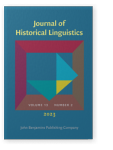Vol. 13:2 (2023) ► pp.255–294
Anticausatives in Classical Armenian
The present study contributes to the description of the coding of anticausatives and causative-anticausative alternation in Classical Armenian based on conventional typologically-oriented questionnaires and a dataset of verbs attested in the Armenian translation of the Bible. The synchronic evidence is then analyzed from a diachronic perspective with an outlook on modern varieties of Armenian and the Proto-Indo-European reconstruction.
It is argued that discriminating between the derivational and inflectional tiers allows for a better explanation of the morphological links between the patterns used to code causative-anticausative alternation in verbs of different semantic types. According to preliminary quantitative estimations, the overall valency orientation of Classical Armenian is dominated by a nondirected equipollent coding strategy. Altogether, when coded by transitivizing pairs, causative-anticausative alternation shows preference for noncausal verbs of the a-conjugation, the paradigm of which typically combines equipollent perfective forms with labile imperfective ones.
An improved descriptive model enables a better cross-linguistic alignment of coding patterns as illustrated by comparing Classical Armenian to other cognate languages. Classical Armenian provides additional evidence on the typologically common split in the coding of causative-anticausative pairs. Whereas the transitivizing and equipollent (and marginally suppletive) patterns are diachronically stable within the prehistory of Armenian, the labile strategy constitutes a major innovation typical for the imperfective part of the verbal paradigm.
Article outline
- 1.Introduction
- 2.The typology of coding of the causative-anticausative alternation
- 3.Causative-anticausative alternation coding in Classical Armenian
- 3.1Nondirected patterns
- 3.2Directed patterns
- 4.Continuity of patterns coding the causative-anticausative alternation
- 5.Basic valency orientation of Classical Armenian
- 6.Diachronic outlook
- 6.1Post-Classical Armenian changes in the coding of valency alternations
- 6.2Proto-Armenian changes in the coding of valency alternations
- 7.Conclusion
- Acknowledgements
- Notes
-
References
